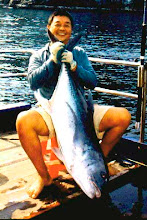 |
| This article was published in the August 2004 issue of Rod and Line Fishing Magazine. |
Whenever I
was free during the rainy seasons, I would be surveying around rivers and
streams, on the lookout for sebaraus hunting for food. They would normally hang
around lubuks, eddies or any place that offer them some shelters from the fast
water current, to lie in wait for the unsuspecting small fishes.
During one
of my rainy season forays, I came across a group of fishermen, lined up along
the bank of the swollen Kinta River fishing with long poles. My curiosity was
immediately aroused as I wondered how these people could do pole fishing in
such swift current.
 |
| Here all the fishermen were lined up along the swollen Kinta River. The river to the left actually was part of the Kinta River that broke its bank nd flowed into a former mining pond. |
That
normally shallow river where one could wade during the dry season was almost like
the Niagara River just before the Niagara Fall. The poles they were using were of
4 meters to five meters in length. The funny thing was all of them dipped the
tips of the poles into the water. My! This was something new to me. Judging
from the number of fish they had in their keep nets, their method was
definitely successful.
 |
| How could any fish escape the nets when they were lifted up |
Suddenly one
of them lifted up his pole and only then did I realize that they were having nets
attached to the ends of their poles. In the net was a lomar fish of very
presentable size. Now, this was something I must learn, I told myself. Walking
over and putting on the most presentable smile, I introduced myself. A few
minutes of pleasant talking, I was examining their contraptions.
 |
| The loop reopened for the next victim. See how successful this method could be by the catch of Pak Cik in the background. |
What an
imaginative and innovative way to catch fish. Instead of hooks, lines and
sinkers, a piece of flexible spring wire of about 4mm in diameter and up to 2
meters in length was tied to the tip of the pole. The other end of the wire was
looped back to the wire and wound about five times round it so that it could
slide along itself thus forming a loop of variable diameter. A net of 2 cm mesh
was the strung across the loop.
To use this
device, the loop was lowered into the slower moving part of the fast flowing
river. Whenever a fish (most fish moving up stream would travel through the
part of the river with the slowest current) hit the net, it would get entangled
in the mesh. When the net was lifted up, the loop
 |
| This jelawat was caught in a pond fed by the Kinta River. |
would close and the fish trapped
in the net. After the fish was removed, the loop was reopened and then lowered
back into the river for the next victim.
For this
device to work the river must be swollen with rain water. Most of the fish
caught that day were lomars as the water was muddy. Whenever the water was less
turbid, lampams would constitute most of the catch, my new friends told me.
Mind you, some can be as big as 1kg to 2 kg in size.
 |
| This net full of lampams were also caught here. |
The
following weekend, I made another trip to the same place. By now, the water
level had subsided considerably. In the place of the pole fishermen, I found
many anglers with the normal arsenals fishing. Using oil palm seeds, their
catches now consisted of jelawats and lampams, Instead of fishing in the main
Kinta River, they were fishing in the pond where the river broke its bank
(hint, hint). Sigh! If only the stretch of the Kinta River flowing through Ipoh
City can be that productive.


No comments:
Post a Comment